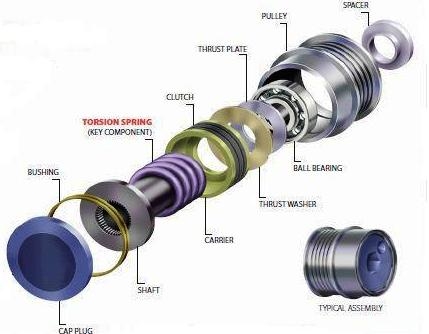Overrunning Alternator Decoupler – Clutch Type Alternator
January 1, 2011 2:36 pm Consumer, DIY, How To Auto RepairOAD stands for Overrunning Alternator Decoupler – Image Courtesy of the Gates Corp.
© DenLorsTools.com Summary: DenLors auto repair blog written by an ASE master tech. Helping to make sense of the clutch type alternator pulleys used on many cars today. Knowing how decoupler pulleys are designed and how they’re suppose to work is the first step in properly diagnosing problems. Many alternators are replaced needlessly due incorrectly diagnosed problems related to this type of pulley.
About Alternator De-coupler Pulleys
First a little history. Ford was the first to introduce the serpentine belt drive system, it was on the 1979 Mustang. Ford’s better idea was to have one belt that wraps around everything. One belt ran the alternator, water pump and power steering. All was driven by the crank pulley. The alternator had a solid pulley. In later years as electronics became a more integral part of cars, the demand for electrical power increased. Larger alternators and higher tension on belts started to cause problems. In the 1990’s, serpentine belt systems had some common problems; vibration, belt chirp and premature belt wear. One way clutch pulleys were developed to help with these issues. The OWC (One Way Clutch) pulley worked like a solid pulley at all times except when the engine slowed down. This worked well for awhile, however engine size has decreased in some cars while alternator size has increased. The OAD (Over-running Alternator Decoupler) pulley was designed to help with increased issues with harshness and vibration problems. A common question is “what is the difference between a one way clutch pulley and an overrunning alternator decoupler pulley?” The primary difference has to do with ONE major component. The TORSION SPRING as seen in the image above. The torsion spring acts as a dampening mechanism which greatly reduces belt vibration. The OAD acts as a one way clutch but has the benefit of reduced harshness thanks to the dampening action of the torsion spring.
Question: How long do O.A.D. (Overrunning Alt. – Pulleys) last?
Answer: OAD type pulleys may have a lifetime of around 50,000 miles.
Question: How can you tell if an alternator has an OAD type pulley?
Answer: OAD pulleys are typically wider than regular pulleys.
Question: How do you check a decoupler pulley?
Answer: Excessive tensioner vibration and belt movement may indicate a failed decoupler pulley. A buzzing sound after the engine has been shut-off could be an indication of a failed alternator decoupler. With the belt off – Hold the armature stationary by inserting an object through the alternator housing vent. The clutch should free-spin in one direction and lock in the other. If the pulley free spins in BOTH directions, it has failed and will cause a no charge condition. If the pulley seems LOCKED in BOTH directions it has failed and will cause excessive vibration and possibly noise.
Related Auto Repair Article and Specialty Tool
Alternator Clutch Type Pulley Kit

Stram :
Date: November 21, 2013 @ 5:15 pm
Great info. Saved me over $100 on a new alternator by simply replacing the pully. Mine was free spinning in both directions and the battery light was on.
dennisb - Auto Tool Sales :
Date: November 21, 2013 @ 5:53 pm
Hey that’s great. Keep us in mind if you need tools in the future.